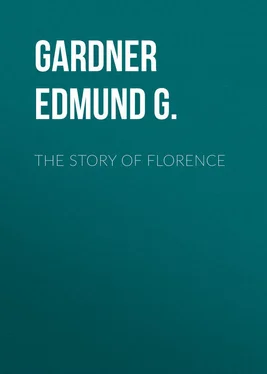Edmund Gardner - The Story of Florence
Здесь есть возможность читать онлайн «Edmund Gardner - The Story of Florence» — ознакомительный отрывок электронной книги совершенно бесплатно, а после прочтения отрывка купить полную версию. В некоторых случаях можно слушать аудио, скачать через торрент в формате fb2 и присутствует краткое содержание. Жанр: История, foreign_antique, foreign_prose, на английском языке. Описание произведения, (предисловие) а так же отзывы посетителей доступны на портале библиотеки ЛибКат.
- Название:The Story of Florence
- Автор:
- Жанр:
- Год:неизвестен
- ISBN:нет данных
- Рейтинг книги:3 / 5. Голосов: 1
-
Избранное:Добавить в избранное
- Отзывы:
-
Ваша оценка:
- 60
- 1
- 2
- 3
- 4
- 5
The Story of Florence: краткое содержание, описание и аннотация
Предлагаем к чтению аннотацию, описание, краткое содержание или предисловие (зависит от того, что написал сам автор книги «The Story of Florence»). Если вы не нашли необходимую информацию о книге — напишите в комментариях, мы постараемся отыскать её.
The Story of Florence — читать онлайн ознакомительный отрывок
Ниже представлен текст книги, разбитый по страницам. Система сохранения места последней прочитанной страницы, позволяет с удобством читать онлайн бесплатно книгу «The Story of Florence», без необходимости каждый раз заново искать на чём Вы остановились. Поставьте закладку, и сможете в любой момент перейти на страницу, на которой закончили чтение.
Интервал:
Закладка:
The first thirty-four years of this epoch are among the brightest in Florentine history, the years that ran from the triumph of the Guelfs to the sequel to the Jubilee of 1300, from the establishment of the Secondo Popolo to its split into Neri and Bianchi, into Black Guelfs and White Guelfs. Externally Florence became the chief power of Tuscany, and all the neighbouring towns gradually, to a greater or less extent, acknowledged her sway; internally, in spite of growing friction between the burghers and the new Guelf nobility, between popolani and grandi or magnates, she was daily advancing in wealth and prosperity, in beauty and artistic power. The exquisite poetry of the dolce stil novo was heard. Guido Cavalcanti, a noble Guelf who had married the daughter of Farinata degli Uberti, and, later, the notary Lapo Gianni and Dante Alighieri, showed the Italians what true lyric song was; philosophers like Brunetto Latini served the state; modern history was born with Giovanni Villani. Great palaces were built for the officers of the Republic; vast Gothic churches arose. Women of rare beauty, eternalised as Beatrice, Giovanna, Lagia and the like, passed through the streets and adorned the social gatherings in the open loggias of the palaces. Splendid pageants and processions hailed the Calends of May and the Nativity of the Baptist, and marked the civil and ecclesiastical festivities and state solemnities. The people advanced more and more in power and patriotism; while the magnates, in their towers and palace-fortresses, were partly forced to enter the life of the guilds, partly held aloof and plotted to recover their lost authority, but were always ready to officer the burgher forces in time of war, or to extend Florentine influence by serving as Podestàs and Captains in other Italian cities.
Dante was born in the Sesto di San Piero Maggiore in May 1265, some eighteen months before the liberation of the city. He lost his mother in his infancy, and his father while he was still a boy. This father appears to have been a notary, and came from a noble but decadent family, who were probably connected with the Elisei, an aristocratic house of supposed Roman descent, who had by this time almost entirely disappeared. The Alighieri, who were Guelfs, do not seem to have ranked officially as grandi or magnates; one of Dante's uncles had fought heroically at Montaperti. Almost all the families connected with the story of Dante's life had their houses in the Sesto di San Piero Maggiore, and their sites may in some instances still be traced. Here were the Cerchi, with whom he was to be politically associated in after years; the Donati, from whom sprung one of his dearest friends, Forese, with one of his deadliest foes, Messer Corso, and Dante's own wife, Gemma; and the Portinari, the house according to tradition of Beatrice, the "giver of blessing" of Dante's Vita Nuova , the mystical lady of the Paradiso . Guido Cavalcanti, the first and best of all his friends, lived a little apart from this Sesto di Scandali–as St Peter's section of the town came to be called–between the Mercato Nuovo and San Michele in Orto. Unlike the Alighieri, though not of such ancient birth as theirs, the Cavalcanti were exceedingly rich and powerful, and ranked officially among the grandi , the Guelf magnates. At this epoch, as Signor Carocci observes in his Firenze scomparsa , Florence must have presented the aspect of a vast forest of towers. These towers rose over the houses of powerful and wealthy families, to be used for offence or defence, when the faction fights raged, or to be dismantled and cut down when the people gained the upper hand. The best idea of such a mediæval city, on a smaller scale, can still be got at San Gemignano, "the fair town called of the Fair Towers," where dozens of these torri still stand; and also, though to a less extent, at Gubbio. A few have been preserved here in Florence, and there are a number of narrow streets, on both sides of the Arno, which still retain some of their mediæval characteristics. In the Borgo Santissimi Apostoli, for instance, and in the Via Lambertesca, there are several striking towers of this kind, with remnants of palaces of the grandi ; and, on the other side of the river, especially in the Via dei Bardi and the Borgo San Jacopo. When one family, or several associated families, had palaces on either side of a narrow street defended by such towers, and could throw chains and barricades across at a moment's notice, it will readily be understood that in times of popular tumult Florence bristled with fortresses in every direction.
In 1282, the year before that in which Dante received the "most sweet salutation," dolcissimo salutare , of "the glorious lady of my mind who was called by many Beatrice, that knew not how she was called," and saw the vision of the Lord of terrible aspect in the mist of the colour of fire (the vision which inspired the first of his sonnets which has been preserved to us), the democratic government of the Secondo Popolo was confirmed by being placed entirely in the hands of the Arti Maggiori or Greater Guilds. The Signoria was henceforth to be composed of the Priors of the Arts, chosen from the chief members of the Greater Guilds, who now became the supreme magistrates of the State. They were, at this epoch of Florentine history, six in number, one to represent each Sesto, and held office for two months only; on leaving office, they joined with the Capetudini, and other citizens summoned for the purpose, to elect their successors. At a later period this was done, ostensibly at least, by lot instead of election. The glorious Palazzo Vecchio had not yet been built, and the Priors met at first in a house belonging to the monks of the Badia, defended by the Torre della Castagna; and afterwards in a palace belonging to the Cerchi (both tower and palace are still standing). Of the seven Greater Arts–the Calimala , the Money-changers, the Wool-merchants, the Silk-merchants, the Physicians and Apothecaries, the traders in furs and skins, the Judges and Notaries–the latter alone do not seem at first to have been represented in the Priorate; but to a certain extent they exercised control over all the Guilds, sat in all their tribunals, and had a Proconsul, who came next to the Signoria in all state processions, and had a certain jurisdiction over all the Arts. It was thus essentially a government of those who were actually engaged in industry and commerce. "Henceforth," writes Pasquale Villari, "the Republic is properly a republic of merchants, and only he who is ascribed to the Arts can govern it: every grade of nobility, ancient or new, is more a loss than a privilege." The double organisation of the People under the Captain with his two councils, and the Commune under the Podestà with his special council and the general council (in these two latter alone, it will be remembered, could nobles sit and vote) still remained; but the authority of the Podestà was naturally diminished.
Florence was now the predominant power in central Italy; the cities of Tuscany looked to her as the head of the Guelfic League, although, says Dino Compagni, "they love her more in discord than in peace, and obey her more for fear than for love." A protracted war against Pisa and Arezzo, carried on from 1287 to 1292, drew even Dante from his poetry and his study; it is believed that he took part in the great battle of Campaldino in 1289, in which the last efforts of the old Tuscan Ghibellinism were shattered by the Florentines and their allies, fighting under the royal banner of the House of Anjou. Amerigo di Narbona, one of the captains of King Charles II. of Naples, was in command of the Guelfic forces. From many points of view, this is one of the more interesting battles of the Middle Ages. It is said to have been almost the last Italian battle in which the burgher forces, and not the mercenary soldiery of the Condottieri, carried the day. Corso Donati and Vieri dei Cerchi, soon to be in deadly feud in the political arena, were among the captains of the Florentine host; and Dante himself is said to have served in the front rank of the cavalry. In a fragment of a letter ascribed to him by one of his earlier biographers, Dante speaks of this battle of Campaldino; "wherein I had much dread, and at the end the greatest gladness, by reason of the varying chances of that battle." One of the Ghibelline leaders, Buonconte da Montefeltro, who was mortally wounded and died in the rout, meets the divine poet on the shores of the Mountain of Purgation, and, in lines of almost ineffable pathos, tells him the whole story of his last moments. Villani, ever mindful of Florence being the daughter of Rome, assures us that the news of the great victory was miraculously brought to the Priors in the Cerchi Palace, in much the same way as the tidings of Lake Regillus to the expectant Fathers at the gate of Rome. Several of the exiled Uberti had fallen in the ranks of the enemy, fighting against their own country. In the cloisters of the Annunziata you will find a contemporary monument of the battle, let into the west wall of the church near the ground; the marble figure of an armed knight on horseback, with the golden lilies of France over his surcoat, charging down upon the foe. It is the tomb of the French cavalier, Guglielmo Berardi, "balius" of Amerigo di Narbona, who fell upon the field.
Читать дальшеИнтервал:
Закладка:
Похожие книги на «The Story of Florence»
Представляем Вашему вниманию похожие книги на «The Story of Florence» списком для выбора. Мы отобрали схожую по названию и смыслу литературу в надежде предоставить читателям больше вариантов отыскать новые, интересные, ещё непрочитанные произведения.
Обсуждение, отзывы о книге «The Story of Florence» и просто собственные мнения читателей. Оставьте ваши комментарии, напишите, что Вы думаете о произведении, его смысле или главных героях. Укажите что конкретно понравилось, а что нет, и почему Вы так считаете.












